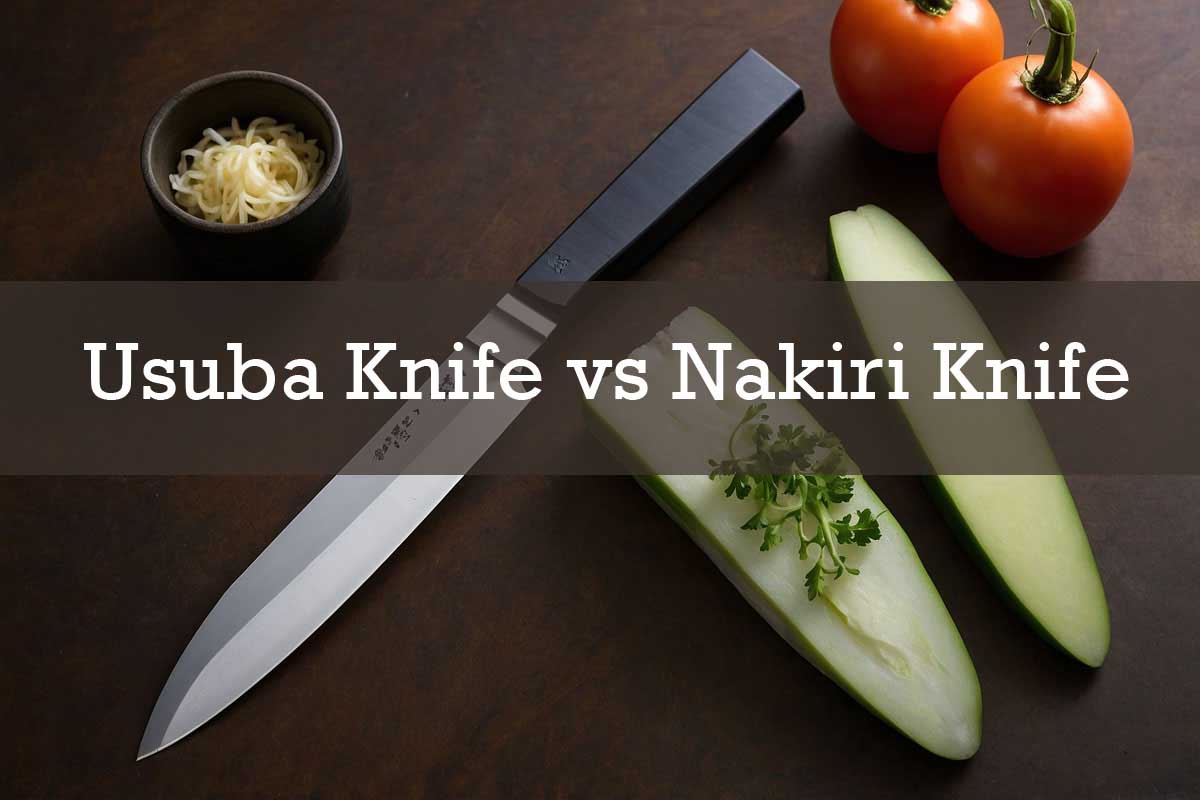Usuba Knife vs Nakiri Knife: Which Japanese Vegetable Knife is Best?

I’m excited to share insights into the usuba knife vs nakiri knife. Both are traditional Japanese vegetable knives with distinct features and uses. Understanding these differences can help you choose the right tool for your kitchen.
The usuba knife and the nakiri knife are staples in Japanese cuisine, each designed to enhance vegetable preparation. By learning about their unique characteristics, you can better appreciate the craftsmanship behind these traditional knives and decide which one suits your cooking style best.
What is a Nakiri Knife?
The nakiri knife is a popular choice among home cooks and professional chefs alike. This knife features a straight blade with a flat front, making it perfect for chopping vegetables. The design allows for a smooth up-and-down motion without rocking, which is ideal for making clean, precise cuts.

One of the main benefits of the nakiri knife is that it’s easy to use. Its design is straightforward, making it suitable for cooks of all skill levels. Whether you’re a beginner or a seasoned chef, you’ll find that the nakiri knife’s efficient and user-friendly design enhances your vegetable prep.
What is an Usuba Knife?
The Usuba knife is a specialized tool favored by professional chefs. It features a single bevel edge, which means it’s sharpened on only one side. This design allows for incredibly precise cuts and is perfect for intricate, decorative work. The ultra-thin blade of the Usuba knife excels in making fine, delicate slices, a necessity in traditional Japanese cuisine.

While the usuba knife is highly effective, it requires more skill to use properly. The single bevel design can be challenging for beginners, but for those who master it, the usuba knife offers unmatched precision and control. It’s the go-to choice for chefs aiming to achieve perfect presentation in their dishes.
Usuba Knife vs Nakiri Knife: Key Differences
Understanding the key differences between Nakiri and Usuba knives can help you make an informed choice. Let’s compare these knives in terms of blade design, bevel, skill requirement, and typical uses.
Blade Design and Bevel
The blade design is one of the most noticeable differences in the Nakiri vs Usuba knife comparison.
- Nakiri: This knife has a double bevel blade, which means it’s sharpened on both sides. This design makes it easy to use and ideal for straight, clean cuts. The double bevel allows for versatile cutting techniques and is user-friendly, even for beginners.
- Usuba: The Usuba knife has a single bevel blade, sharpened only on one side. This feature allows for more precise cuts but requires a higher level of skill to use effectively. The single bevel design excels in making ultra-thin slices and intricate cuts but can be challenging for those not familiar with its handling.
The difference in bevel impacts both cutting performance and ease of use. While the Nakiri is more forgiving and suitable for a variety of cutting tasks, the Usuba offers superior precision for detailed work.
Intended Use and Skill Requirement
When considering Nakiri vs Usuba, it’s essential to understand their intended uses and the skill required to use them effectively.
- Nakiri: This knife is perfect for everyday use and excels in vegetable chopping. Its straightforward design makes it accessible to cooks of all skill levels. The Nakiri is great for making uniform cuts quickly and efficiently, making it a versatile tool in any kitchen.
- Usuba: The Usuba is designed for specialized use, particularly in making fine, decorative cuts. This knife is a favorite among professional chefs who need to create intricate presentations. However, its single bevel design and need for precise handling mean that it requires more skill to use effectively.
In summary, the Nakiri is suitable for general vegetable chopping and everyday use, while the Usuba is best for those who need to perform specialized, decorative work.
Sharpening and Maintenance
Knife maintenance is an important aspect to consider when choosing between these two knives.
- Nakiri: This knife is generally easier to maintain and sharpen. Its double bevel design makes it straightforward to sharpen with standard sharpening tools. Regular maintenance keeps the Nakiri in optimal condition without much hassle.
- Usuba: The Usuba requires more delicate handling and sharpening techniques. The single bevel edge means that it needs to be sharpened more carefully to maintain its precision. This can be more time-consuming and requires specific sharpening stones and techniques to ensure the blade remains in top condition.
In terms of knife maintenance, the Nakiri is more user-friendly, while the Usuba demands a higher level of care and attention to detail.
See more: Boning Knife vs Fillet Knife
FAQs on Usuba Knife vs Nakiri Knife
Last Words
Choosing between the Nakiri vs Usuba depends on your skill level and cooking style. If you’re looking for a versatile, user-friendly knife, the Nakiri is the best knife for everyday vegetable chopping.
For those with advanced skills seeking precision, the Usuba is ideal for detailed, decorative cuts. Both knives offer unique benefits and can enhance your kitchen experience.
Consider your needs and preferences to decide which one fits your culinary tasks. Happy cooking!
Also know: Carbon Vs Stainless Steel Knife
